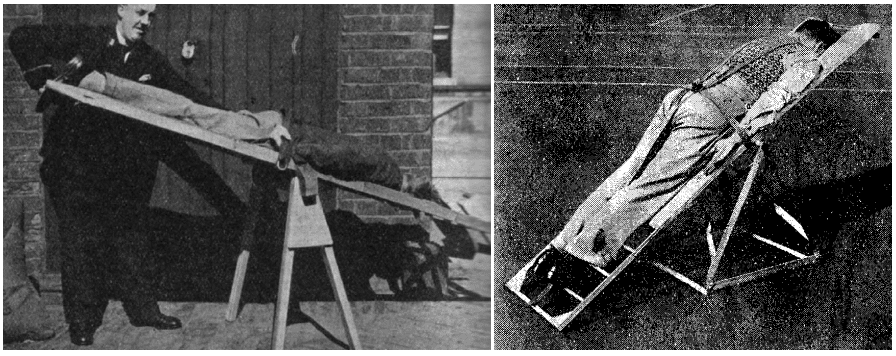Frank Eve
Frank Cecil Eve (1871 – 1952) was an English physician
Eve’s medical interests were many and varied; they included pernicious anaemia, diabetes, clinical psychology, and artificial respiration
His medical publications were practical and based on physical principles. He described a method of controlling the treatment of diabetes by a sugar-fermentation test that could be used on the ward; devised a special needle for cisternal puncture; and a simple instrument for more accurately determining heart measurements.
As a young man he was a considerable golfer, figure-skater, skier and fisherman; past president of the East Riding division of the British Medical Association and a former chairman of the Hull Medical Society.
Epomnymously remembered for his method for artificial respiration published in 1932; Eve’s rocking method was extensively studied bye Edgar Pask (1912 – 1966) and Sir Robert Reynolds Macintosh (1897 – 1989) and in 1943, adopted by the Royal Navy and the Swedish Navy and brought him international fame.
Biography
- Born on February 15, 1871 at Silsoe, Bedfordshire
- Educated at Bedford school
- 1893 – BA (first class) in Natural Sciences Tripos at Emmanuel College, Cambridge
- 1896 – Demonstrator of physiology at Yorkshire College, Leeds
- 1900 – MB, St. Thomas’s Hospital, London. House officer at St. Thomas’s Hospital and the Hull Royal Infirmary
- 1901 – MRCP
- 1903 – MD, University of Cambridge
- 1906 – Physician to Hull Royal Infirmary
- 1915 – FRCP
- 1927-1928 President of the East Yorkshire and North Lincolnshire Branch of the British Medical Association
- 1929 – Published on the early diagnosis of pernicious anaemia by the halometer – a portable apparatus in which a blood film is viewed through a peephole; a single movable source of light is adjusted until the two innermost red rings touch. The instrument is calibrated to read the mean diameter of the red cells.
- 1932 – Published his most important contribution on a new, “rocking“, method of artificial respiration.
- 1943 – Eve’s rocking method of artificial respiration officially adopted by the Royal Navy
- Consulting physician to the Hull Royal Infirmary and Victoria Hospital for Sick Children
- Died on December 7, 1952 in Beverley, Yorkshire
Medical Eponyms
Eve’s rocking method of artificial respiration (1932)
Formerly, I regarded the breathing thorax as a concertina bellows; my present works suggest that it resembles a cylinder and piston. In older men, the cylinder wall is often rigid and scarcely used in respiration at rest. Hence, in artificial respiration it seems much better to exploit the piston action of the diaphragm rather than try to compress the rigid walls of the cylinder…
Essentially, the method consists of laying the patient on a stretcher, which is pivoted about its middle on a trestle and rocking up and down rhythmically so that the weight of the viscera pushes the flaccid diaphragm alternately up and down. Anyone can convince himself that this method of artificial respiration is adequate by lying on the apparatus in action. He will find that he need not breathe; it is done for him. Oxygen is not required—only air
Eve FC, Lancet. 1932

In 1932, Eve provided two illustrative case reports to support his contentions. The first was a 2-year-old girl with postdiphtheritic diaphragmatic paralysis, and the second a 24-year-old man with Landry’s paralysis.
In radiographic experiments on himself and his 18 year old son, Eve used chest X-rays to demonstrate a diaphragmatic movement of 5 cm. Using their chest measurements he calculated that this 5 cm excursion of the diaphragm amounted to 1800cc of air movement, compared to 1000cc of air movement using the Schafer method of artificial respiration
In 1933, Eve published with Esther Killick from the Department of Physiology at the University of Leeds the results of their physiological experiments on the rocking and other methods of artificial respiration. They compared the tidal air during artificial respiration in healthy subjects and found that with Silvester’s method the tidal air was about 200cc, with the Schafer method it was 350–550cc and with Eve’s rocking method 450–600 cc.
In 1941, Edgar Pask reviewed a range of methods of artificial respiration in the unconscious intubated patient (himself…) including the Silvester method; the Shaefer method; and Eve’s rocking method. Pask found Eve’s rocking method to ne the most useful on rescue boats.
In 1950, Gordon et al measured pulmonary air exchange in “recently deceased warm corpses, prior to the onset of rigor mortis and…within one hour of cessation of the heart beat”. They found that the Schafer method averaged 185cc; Eve’s rocking technique 225cc, and the Silvester technique 520 cc.
Major Publications
- Eve FC. The early diagnosis of pernicious anaemia by the halometer. Br Med J. 1929 Jul 13; 2(3575): 48-9.
- Eve FC. Actuation of the inert diaphragm by a gravity method. Lancet 1932; 220(5697): 995-997
- Killick EM, Eve FC. Physiological investigation of the rocking method of artificial respiration. Lancet 1933; 222(5744): 740-742
- Eve FC. Resuscitation of the Drowned. Br Med J. 1943 May 1;1(4295):535-7.
- Eve FC. Resuscitation in Rescue Boats. Br Med J. 1945 Jan 6;1(4383):21-2.
- Eve FC. Artificial circulation produced by rocking; its use in drowning and anaesthetic emergencies. Br Med J. 1947 Aug 23;2(4520):295
- Eve FC, Forstyth NC. Asphyxia of the newborn treated by rocking. Br Med J. 1948 Sep 18;2(4576):554
References
Biography
- Obituary: Frank Cecil Eve. Lancet 1952; 260(6748): 1276-1277
- Obituary: Frank Cecil Eve. Br Med J 1952; 2: 1362
- Biography: Frank Cecil Eve. Lives of the Fellows of the Royal College of Physicians of London. Munk’s Roll: Volume IV: 544.
- Bibliography. Eve, Frank C. (Frank Cecil) 1871-1952. WorldCat Identities
Eponymous terms
- Gordon AS, Fainer DC, Ivy AC. Artificial respiration; a new method and a comparative study of different methods in adults. J Am Med Assoc. 1950 Dec 23;144(17):1455-64.
- Gordon AS, Sadove MS, Raymon F, Ivy AC. Critical survey of manual artificial respiration. J Am Med Assoc. 1951 Dec 8;147(15):1444-53
- Thangam S, Weil MH, Rackow EC. Cardiopulmonary resuscitation: a historical review. Acute Care. 1986;12(2):63-94
- Baskett TF. The resuscitation great: Eve’s rocking method of artificial respiration. Resuscitation. 2005 Jun;65(3):245-7.
[cite]
Doctor currently working in South Wales, training in anaesthetics. Graduated Leeds University with MB ChB with BSc in microbiology in relation to medicine. Special interests in emergency medicine, critical care and anaesthetics

